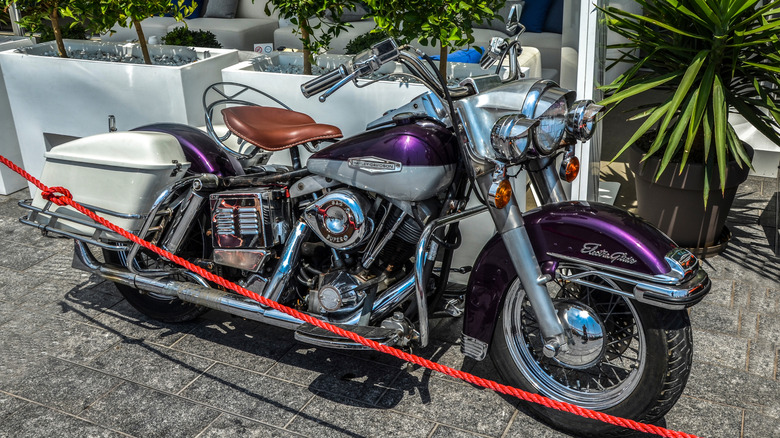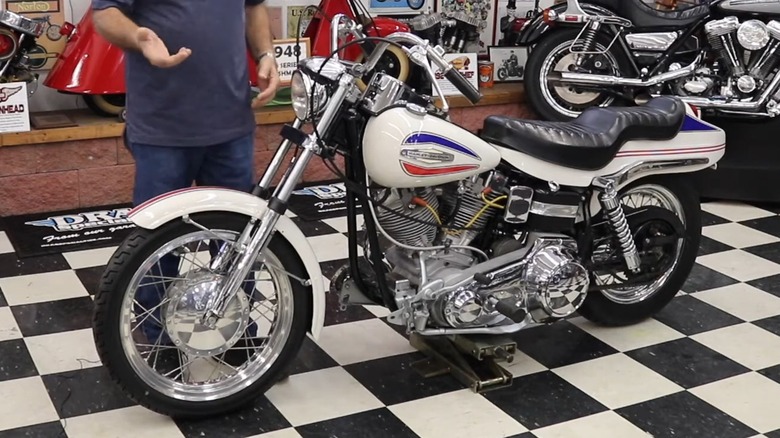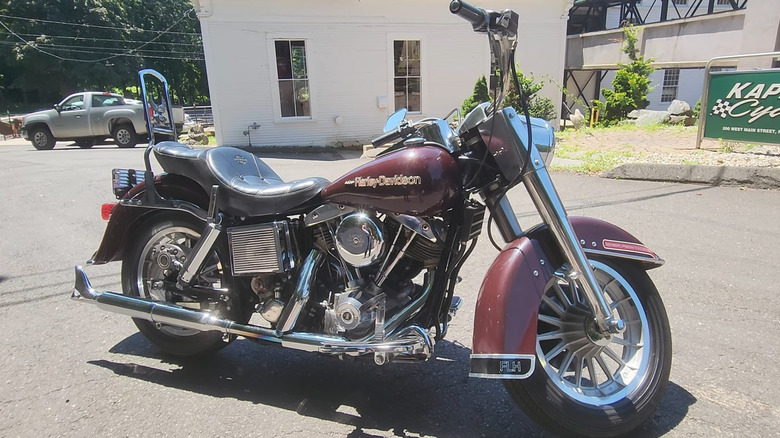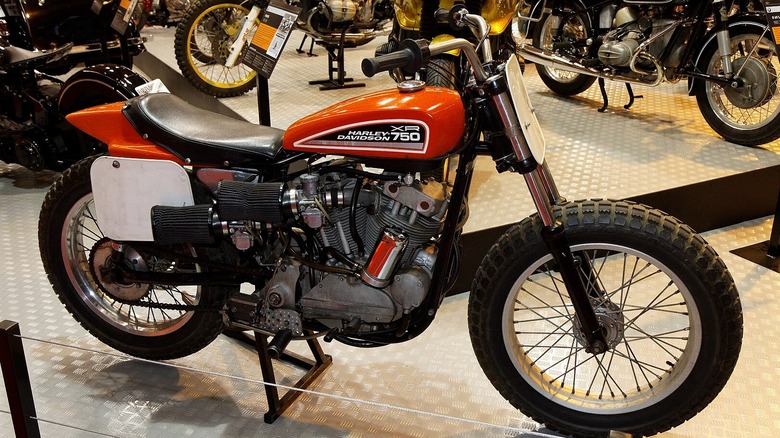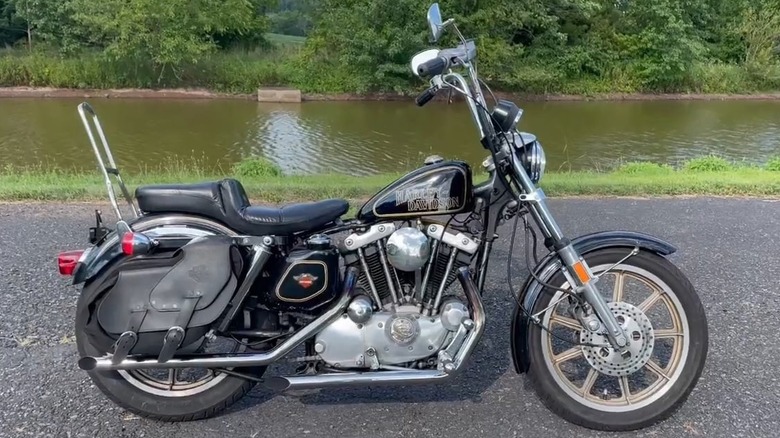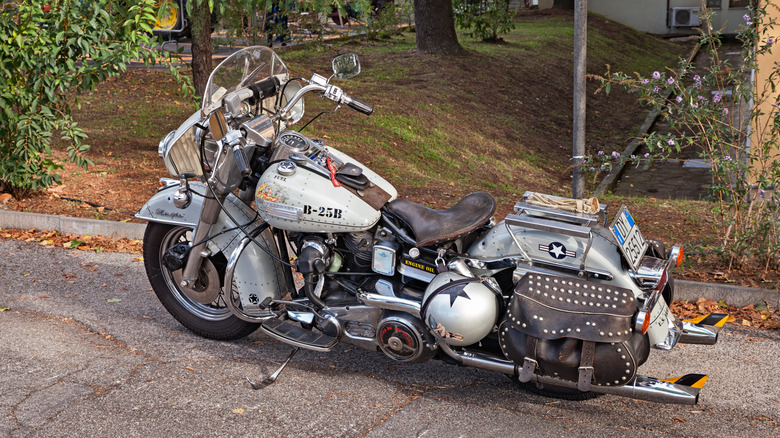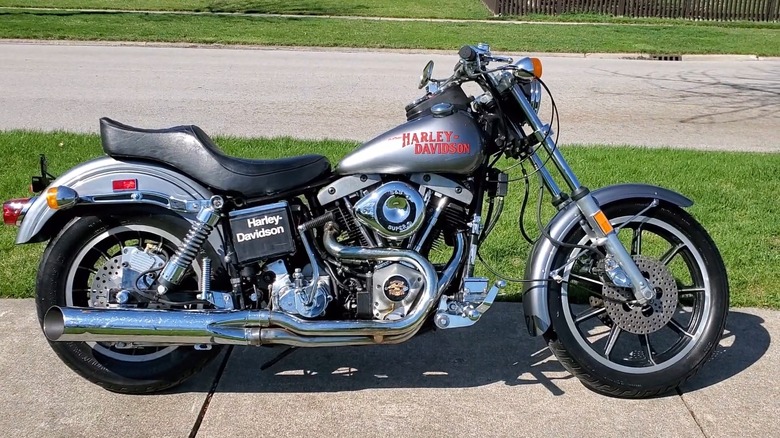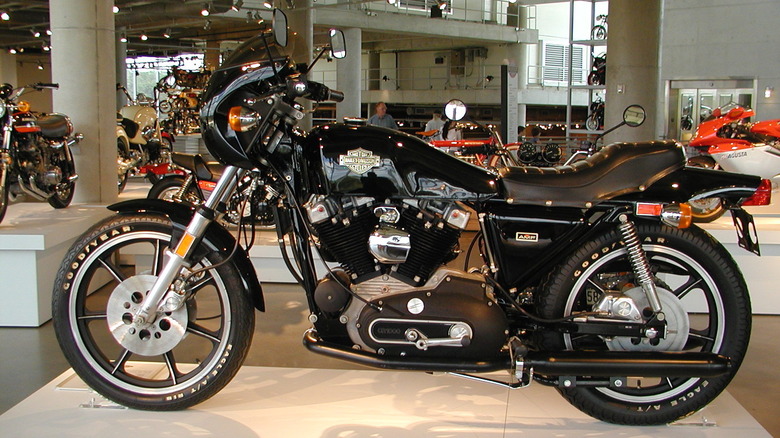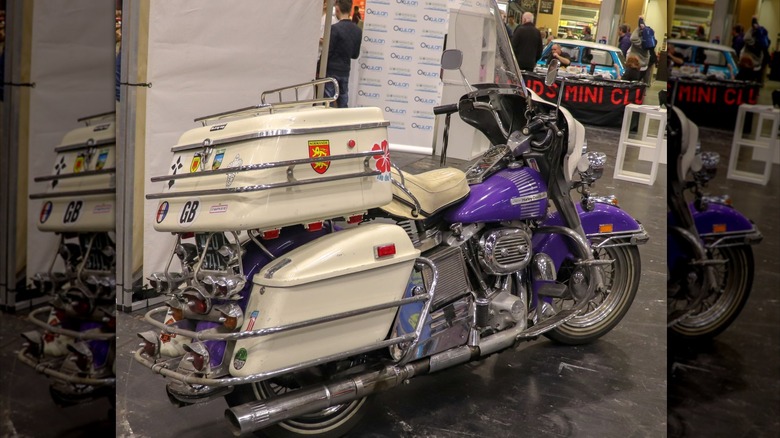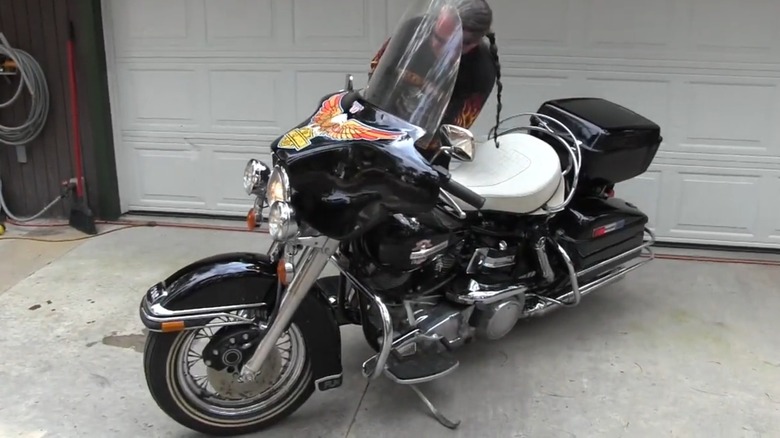9 Iconic Harley-Davidson Motorcycles From The 1970s
The 1970s proved to be a transformative decade for Harley-Davidson, as the company not only saw many of its motorcycles achieve legendary status and are still popular even now, it was a time when the company went full throttle into experimentation and innovation. For instance, the decade marked the first time the American motorcycle company introduced a factory custom bike — the FX Super Glide – while also upgraded certain models, such as the Sportster, to appeal to younger audiences.
Despite the company's decades of success, the 1970s are remembered as a difficult time for Harley-Davidson. The company was struggling with the competition of Japanese manufacturers who provided the public with lightweight, fast, and cheap motorcycles. The decade also saw the company dealing with new ownership, as American Machine and Foundry (AMF) had acquired Harley-Davidson in 1969, leading to a period of financial instability and quality control issues.
Still, the Harley-Davidson brand stood strong, steered through the ruckus, and introduced some iconic motorcycles during this era. Here are some of our favorites.
1971 Harley-Davidson FX 1200 Super Glide
In the early 1970s, Harley-Davidson engineers combined parts from two of its popular models — the Big Twin FL and the XL Sportster — to create Harley-Davidson's first factory custom bike, the 1971 Harley-Davidson FX 1200 Super Glide. It delivered the performance of a cruiser with the styling of a custom bike and was powered by a 1,200cc Shovelhead V-twin engine producing 65 hp.
The 1971 Harley-Davidson FX Super Glide was fitted with a rear suspension from the FL model and a dual tank from the FLH model, wrapped in a Sparkling America paint scheme. One of the most distinctive features was the boat tail rear fender, which gave the bike an aggressive look. Thanks to the fork-mounted fairing and responsive suspension, the 1971 FX Super Glide offered its riders excellent handling.
Despite so much on offer straight from the factory and being one of the most significant additions to the legendary Harley-Davidson lineup, the 1971 FX Super Glide was a commercial disappointment, selling fewer than 5,000 units. This was pretty low, especially when comparing it to the 10,000 plus Sportsters and roughly 6,700 FL/FLH models sold in the same year. The FX Super Glide did return the next year, but without the tail section.
1978 Harley-Davidson FLH Electra Glide
The FLH Electra Glide – along with the stripped-down sport version introduced in 1977, the FLHS Electra Glide – was Harley-Davidson's staple in the touring motorcycle segment during the 1970s. With its combination of power and comfort, it was known as a favorite for long-distance riders. The 75th Anniversary Edition featured a 1,200 cc V-twin engine that generated around 58 hp and was decorated with gold pinstriping on the wheels along with an eagle emblem on the clutch cover.
Equipped with an air-cooled, four-stroke engine and manual transmission, the 1978 FLH Electra Glide was one of the largest-capacity bikes built by an American company at the time. The optional batwing fairing provided excellent wind protection, while the large fuel tank allowed for extended riding without frequent pit stops — one of the key reasons for its popularity among riders. In addition, a comfortable seat further enhanced its appeal as a great touring motorcycle in the 1970s.
The Electra Glide was also equipped with an electric starter, a staple of this model since 1965, and is considered one of the cheapest models to maintain.
1975 Harley-Davidson XR-750
The Harley-Davidson XR-750 is one of the most iconic motorcycles made by the company during the 1970s and it remains well known today. It was especially legendary in the world of flat-track racing, as the Harley-Davidson XR-750 dominated the American Motorcyclist Association (AMA) Grand National Championships by winning 29 of the 37 championships it competed in from 1972 to 2008.
As the name implies, the bike was powered by a 750cc V-twin engine generating around 82 hp and could hit a top speed of 115 mph. The body of the XR-750 was lightweight, weighing just around 320 lbs, making it highly agile and responsive on the race track. The suspension also offered the stability required at high speeds, contributing to the legacy of the bike in the world of motorcycle racing.
Basking in the success of the Harley-Davidson XR-750, the company also introduced a road racing version which they named the XRTT. The XR-750 was also a popular stunt bike and a favorite of the daredevil legend Evel Knievel. From 1970 to 1976, Evel Knievel used the XR-750 in numerous record-breaking jumps, including his famous 1971 jump over 19 cars.
1978 Harley-Davidson Sportster XLH 1000 75th Anniversary
The Sportster lineup has been a Harley-Davidson staple since 1957 and is one of the longest-produced motorcycles to date. To commemorate the company's 75th anniversary, Harley-Davidson released a special version of the base Sportster called the 1978 Harley-Davidson Sportster XLH 1000 75th Anniversary. Unlike the base Sportster, this special edition version featured gold pinstriping on the wheels and a bunch of 75th anniversary logos. It also featured a dual seat.
The bike was powered by a four-stroke 997cc V-Twin engine that produced 57 hp at 5,800 rpm. The 1978 Harley-Davidson Sportster XLH 1000 75th Anniversary Edition featured dual disk brakes at the front, enhancing stopping power. The anniversary edition was an instant hit among collectors, and you can get a good price for this special edition if you own one. Also, the model came with several accessories, including a special key fob and a certificate of authenticity. The XLH models have always featured electric starters since they debuted in 1967.
Harley-Davidson Sportsters are always trusted for their reliability and performance and are available at an affordable price. Sportsters opened gates for easy modifications, allowing riders to truly customize their bikes their way. Harley-Davidson Sportster's relatively lightweight design made it easy to maneuver, especially for new riders.
1970 Harley-Davidson FLH 1200 Electra Glide Police Special
Multiple Harley-Davidson motorcycles have gained popularity in movies, and one of the most notable is the FLH 1200 Electra Glide Police Special. This specialized model became widely recognizable after featuring in the crime thriller "Electra Glide in Blue." In the film, actor Robert Blake rode the Electra Glide while playing Arizona motorcycle cop John Wintergreen.
The 1970 Harley-Davidson FLH 1200 Electra Glide Police Special was powered by a 1,200cc engine generating almost 58 hp at 5,150 rpm with a top speed of 102 mph. The bike featured a telescopic fork front suspension with twin shock swingarm rear suspension, ensuring a smooth ride. The FLH 1200 Electra Glide Police Special featured a black and white paint scheme along with sirens and lights, making it instantly recognizable as a police vehicle.
Subsequent models were refined to meet modern standards and the Electra Glide continues to be a police favorite. For instance, the version used throughout the 1980s featured a 1,340cc engine and Harley-Davidson also fitted the bike with various specialized police gear, including high-performance brakes allowing for excellent stopping power and control.
1978-1979 Harley-Davidson Low Rider
Introduced by Harley-Davidson in 1977, the Low Rider became an instant hit among bikers, and it became the best-selling model from the company in the first year of its launch. The Harley-Davidson Low Rider — also called the FXS — was powered by a 1,207cc V-Twin engine and its low seat height and good width made it suitable for riders of all sizes. The 1977 model featured alloy wheels and a teardrop-style fuel tank, adding to its distinct look.
The 1978-1979 model of the Low Rider generated 58 hp at 5,150 rpm and offered a blend of power and agility. It could be used as a tourer as it could go up to a max speed of around 100 mph. The bike packed a telescopic front forks and dual side-mounted shock absorbers on the rear, which it retained from its previous models. The Low Rider featured a generous amount of chrome, adding to its appeal.
Low Riders remain popular today and continue to be in production, with the latest models being the Low Rider S and Low Rider ST.
1977-1979 Harley-Davidson XLCR 1000 Cafe Racer
During the AMF years, there was a brief phase in Harley-Davidson's history when it ventured into the cafe racer segment and produced the XLCR 1000 Cafe Racer. However, due to an identity crisis — it was neither a true cafe racer nor a comfortable touring bike — it was discontinued after a brief production run from 1977 to 1979. However, that short lifespan is one of the key reasons why the Harley-Davidson XLCR 1000 Cafe Racer is so iconic.
The bike featured a 997cc air-cooled engine producing 68 hp at 6,200 rpm. While there are stories that the XLCR 1000 Cafe Racer was designed by Willie G. Davidson, the bike was a collaborative effort of three people, including Bob Modero, an independent contractor alias Jim Haubert, and Willie G. The bike built on the then-current model of the Sportster, sharing engine and transmission from the Sportster lineup.
Due to its short production run, less than 4,000 units were built, and only 1,923 XLCRs were sold in 1977, with only nine units selling in 1979, making it a rare collector's item. The product didn't sell well because, as per Cycle World, the bike was designed with only one person in mind — Willie G. himself. The Harley-Davidson XLCR 1000 Cafe Racer had a higher price tag than its competition but offered lackluster performance, making it difficult to compete with rival motorcycles in the segment.
1973 Harley-Davidson FL Electra Glide
After AMF took control of the Harley-Davidson motorcycle company in 1970, significant changes were made to the FLH models, even though the AMF logo did not appear on Harley-Davidson motorcycles until 1971. The 1973 FL Electra Glide was one of the models to feature both the AMF and the Harley-Davidson logos on its fuel tank. Designed for long distances, the Electra Glide gained iconic status. In fact, a Cycle World article from 1973 stated that any rider on an Electra Glide could be positive about one thing — they were being watched by the world.
The 1973 Harley-Davidson FL Electra Glide was also sold with the King of the Road package, which included a windshield, spotlights, a luggage rack, front and rear safety bars, fiberglass saddlebags along with chrome-plated guards, twin mirrors, and a tiny bag on the lower back portion of the windshield. The 1973 FL Electra Glide featured a 1,207cc air-cooled engine producing 58 hp at 5,150 rpm with a top speed close to 100 mph.
It was in the year 1973 that the Electra Glide was fitted with a new disk brake on the front, allowing for better braking. While the electric start was introduced on Electra Glide bikes in 1967, 1973 marked the complete removal of the kick-start pedal from the lineup.
1976 Harley-Davidson FLH Bicentennial Liberty Edition
The 1970s also saw a lot of iconic and special edition models from Harley-Davidson under the leadership of AMF. The American motorcycle company launched a limited-edition 1976 Harley-Davidson FLH Bicentennial Liberty Edition to commemorate the 200th anniversary of the United States. Other models, including the FX Super Glide and XLH Sportster models, were also available in the Bicentennial Liberty Edition.
These Liberty Edition motorcycles rocked a black paint scheme with special commemorative decals. While the 1976 Harley-Davidson FLH Bicentennial Liberty Edition also featured a colorful eagle emblem on the side of the tanks, the Super Glide had a large eagle graphic covering the entire fuel tank. Chrome was heavily used on the bike with the dual exhausts, wheels, trim, and accessories all featuring chrome accents. Fun fact — the 1976 Harley-Davidson FLH Bicentennial FLH was also the last Harley-Davidson purchased by Elvis Presley.
The 1976 Harley-Davidson FLH Bicentennial Liberty Edition was powered by a 1,207cc V-Twin engine with a single disk brake on the front and back. The FLH model was based on Electra Glide, which featured an electric starter and came with full touring accessories, including saddlebags, a top case, and batwing fairing. According to Mecum Auctions, only 750 Bicentennial FLH special edition models were produced, making this model truly iconic and one of the rarest Harley-Davidson models.
